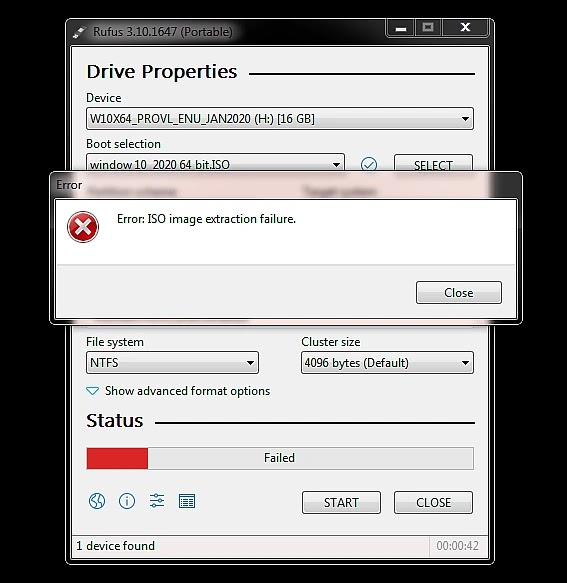How to solve Error ISO image extraction failure.
Rufus is a small program for converting a normal flash drive into a complete bootable USB from which you can directly start in DOS.
Configuring the program is as simple as inserting the device you want to format, marking the options you want, and clicking “start.” In just a few seconds your new bootable USB for DOS drive will be ready.
Rufus is a very small, light, helpful, and easy-to-use tool. If you need to start your computer in DOS for whatever reason, this is one of the best ways.
How to solve this Error ,
- Format your USB flash driver by NTFS file system format.
what is windows image file
The Windows Imaging Format (WIM) is a file-based disk image format. It was developed by Microsoft to help deploy Windows Vista and subsequent versions of the Windows operating system family, as well as Windows Fundamentals for Legacy PCs.
Design
Like other disk image formats, a WIM file contains a set of files and associated file system metadata. However, unlike sector-based formats (such as ISO or VHD), WIM is file-based: The fundamental unit of information in a WIM is a file.
The primary advantages of being file-based is hardware independence and single-instance storage of a file referenced multiple times in the file system tree. Since the files are stored inside a single WIM file, the overhead of opening and closing many individual files is reduced. The cost of reading or writing many thousands of individual files on the local disk is negated by hardware and software-based disk caching as well as sequential reading and writing of the data.
WIM files can contain multiple disk images, which are referenced either by their numerical index or by their unique name. Due to the use of single-instance storage, the more each successive disk image has in common with previous images added to the WIM file, the less new data will be added. A WIM can also be split (spanned) into multiple parts, which have the .swm extension.
WIM images can be made bootable (WIMBoot). Windows boot loader supports booting Windows from within a WIM file. Windows Setup DVD in Windows Vista and later use such WIM files. In this case, BOOT.WIM contains a bootable version of Windows PE from which the installation is performed. Other setup files are held in the INSTALL.WIM.
WIM supports three families of LZ77-based compression algorithms in ascending ratio and descending speed: XPRESS, LZX, and LZMS. The former two use Huffman encoding, while the latter uses adaptive Huffman encoding with range coding. There is also support for solid compression. Both solid compression and LZMS are introduced more recently, in WIMGAPI Windows 8 and DISM Windows 8.1.
Tools
ImageX
ImageX is the command-line tool used to create, edit and deploy Windows disk images in the Windows Imaging Format. Along with the underlying Windows Imaging Interface library (WIMGAPI), It is distributed as part of the free Windows Automated Installation Kit (WAIK/OPK). Starting with Windows Vista, Windows Setup uses the WAIK API to install Windows.
The first distributed prototype of ImageX was build 6.0.4007.0 (main.030212-2037). It allowed Microsoft OEM partners to experiment with the imaging technology and was developed in parallel with Longhorn alpha prototypes. It was first introduced in Milestone 4 into the Longhorn project, and used in later builds of Longhorn. Build 6.0.5384.4 added significant advantages over previous versions, like read-only and read/write folder mounting capabilities, splitting to multiple image files (SWM), a WIM filter driver and the latest compression algorithms. It has been used since pre-RC (release candidates) of Windows Vista.
DISM
Main article: Windows Assessment and Deployment Kit
Deployment Image Service and Management Tool (DISM) is a tool introduced in Windows 7 and Windows Server 2008 R2 that can perform servicing tasks on a Windows installation image, be it an online image (i.e. the one the user is running) or an offline image within a folder or WIM file. Its features include mounting and unmounting images, querying installed device drivers in an offline image, and adding a device driver to an offline image. It is now possible to repair with DISM any image using either a Windows Installation CD or Windows Update.
Before Windows Server 2012 and Windows 8, DISM had incorporated the majority of ImageX functions but not all; ImageX was still needed for image capture. However, DISM deprecated ImageX in Windows 8.
Support in other operating systems
Since April 30, 2012, an open source library for handling the WIM format is available. This library can be used on Unix-like systems as well as on Windows. Thanks to this project, Linux distributions now have their own imagex clone called wimlib-imagex which allows mounting WIM images and managing them (read/write) like any other file system.
As WIM images use somewhat common compression algorithms, they can be accessed by using file archivers like 7-Zip.
For other operating systems that might not support this format, it is still possible to convert .wim images to the more commonly used ISO image using the Windows Assessment and Deployment Kit on Windows.

You need personal informations from companies,family and friends that will better your life and you need easy access without them noticing or you’re financially unstable and you have a bad credit score, come to Brillianthackers800@gmail.com he will solve that without stress,he and his team can clear criminal records without leaving a trace and can also anonymously credit your empty credit cards with funds you need,all these things and more this hacker and his team will do cause they keep you updated on every step taken in order to achieve the goal and they also deliver on time,I tested and confirmed this I’m still happy on how my life is improving after my encounter with them, you can send a mail to Brillianthackers800@gmail.com